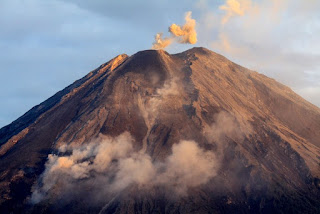Mount Semeru in Lumajang Regency, East Java, erupted on Saturday (4/12) at around 15.00 WIB. This incident caused casualties.
It is known, Mount Semeru issued a hot cloud avalanche (APG). Residents around Mount Semeru were running in panic to avoid the clouds, and the affected settlements were in complete darkness due to a blackout.
Behind the vomit that caused many victims, Mount Semeru became one of the most famous volcanoes in Indonesia. Here are a number of interesting facts about Mount Semeru as summarized by us from various sources:
1. The highest peak on the island of Java
Mount Semeru or Mount Meru is the highest mountain on the island of Java, with its peak Mahameru being 3,676 meters above sea level (masl). This mountain was formed due to the subduction of the Indo-Australian Plate under the Eurasian Plate. Mount Semeru is also the third highest volcano in Indonesia after Mount Kerinci in Sumatra and Mount Rinjani in West Nusa Tenggara.
2. Toxic gas
The crater at the top of Mount Semeru (Peak Mahameru) is known as Jonggring Saloko. At Mahameru Peak, climbers are advised not to go to the Jonggring Saloko crater, also from climbing from the south side, because of toxic gases, hot clouds, and lava flows.
This poisonous gas and hot cloud is known as wedhus gembel which in Javanese means dreadlocks goat, which is a goat that has hair like dreadlocks because of its similar appearance.
Wedhus gembel eruptions occur every 15-30 minutes at the peak of Mount Semeru which is still active. During the day the wind direction is towards the summit, so avoid coming during the day at the summit, because the toxic gases and eruptions lead to it.
3. The first recorded eruption was in the 1800s
The first recorded eruption record is estimated at November 8, 1818. In the 1829-1878 range there were also several eruptions until 1913, but not much information is documented.
The eruptions in the 19th century AD occurred in 1829, 1830, 1832, 1836, 1838, 1842, 1844, 1845, 1848, 1851, 1856, 1857, 1860, 1864, 1867, 1872, 1877, and 1878. This mountain erupted again in 1884 to 1899.
4. Sacred for Hindus
In Hinduism there is a belief about Mount Meru. This mountain is the house where the gods reside and as a means of connecting between Earth (humans) and Heaven. Many Javanese and Balinese people still think of the mountain as the abode of Gods, Hyangs, and spirits.
According to the Balinese, Mount Mahameru is believed to be the father of Mount Agung in Bali and is respected by the Balinese people. The offering ceremony to the gods of Mount Mahameru is performed by the Balinese. The ceremony is carried out once every 8-12 years only when people receive a magical voice from the god of Mount Mahameru.
5. The paradise of flora and fauna
This mountain is included in the Bromo Tengger Semeru National Park area. This National Park consists of mountains and valleys covering an area of 50,273.3 hectares. There are several mountains within the Mount Tengger Caldera, including: Mount Bromo (2,392 m), Mount Batok (2,470 m), Mount Kursi (2,581 m), Mount Watangan (2,662 m), and Mount Widodaren (2,650 m). In addition, there are four beautiful lakes (ranu), namely Ranu Pani, Ranu Regulo, Ranu Kumbolo, and Ranu Darungan.
Bromo Tengger Semeru National Park stores at least 1,025 species of flora and 38 species of fauna that are protected according to Government Regulation No. 7 of 1999 concerning the Preservation of Plant and Animal Species, which consists of 24 species of aves, 11 species of mammals, 1 species of reptile, and 2 species of insects.
There are various types of flora in the Mount Semeru area, but many are dominated by spruce, acacia, pine, and Jamuju species. Meanwhile, the undergrowth is dominated by kirinyuh, reeds, tembelekan, harendong and white edelwiss. Edelwis is also commonly found on the slopes leading to the summit of Semeru. There are also several types of endemic orchids that live around Mount Semeru in the south.
While the fauna that inhabit Mount Semeru include panthers, budeng, mongoose, deer, deer, and others. In addition, at Ranu Kumbolo there are grouses that still live wild.


